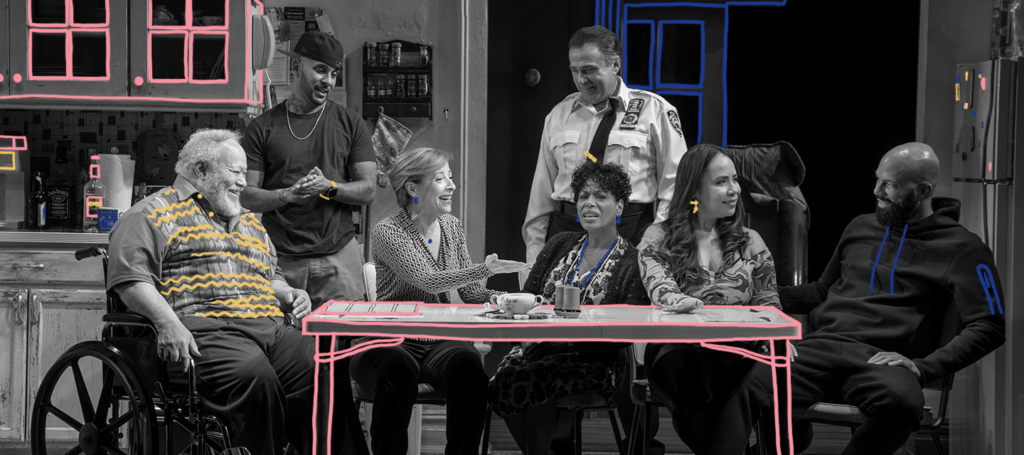


Complex Men and Caricatures of Women Are Caught ‘Between Riverside and Crazy’
Walter “Pops” Washington, as he self-describes in Stephen Adly Guirgis’ Pulitzer-winning play Between Riverside and Crazy, is “a flesh and blood, pee standing up, registered Republican.” He is also a litigious former cop caught within the crossroads of bureaucracy, racism, life as a widower, and a fast-gentrifying Riverside Drive. He also happens to be Black.
Set in Bill de Blasio’s New York in 2014, Between Riverside and Crazy presents a world that is waiting to implode — Walter’s son Junior (the rapper Common making his Broadway debut) is out on parole, his girlfriend Lulu (Rosal Colón), who may or may not be pregnant, and Walter’s former colleagues in the force, Detective Audry O’Connor (Elizabeth Canavan) and her fiance Lieutenant Caro (Michael Rispoli) are trying to make him sign a settlement with City Hall to put an end to a long-standing court battle with the NYPD. Then, there is Junior’s friend, Oswaldo (Victor Almanzar), a recovering addict (also on parole), and a Church Lady (Liza Colón-Zayas) who won’t leave Walter alone. But there is quite a bit of Rudy Giuliani bashing which feels somewhat of a release.
The apartment Walter (national treasure, Stephen McKinley Henderson) lives in, is massive (by Manhattan standards) and yet there is not a second where the play doesn’t feel claustrophobic — decisions, like bills and subpoenas, pile up and Walter is constantly confronted with emotional landmines and endless decisions. This is a play where people are as “real” as they get — equal parts gentle, conniving, lying, and toxic — but no one gets to play god and there is no salvation. This is unsettling because we always want to see the old, curmudgeonly man reveal a heart of gold. Except, no one has that here.
As a play that, within the first few minutes, establishes itself as a being about cops and fugitives, Between Riverside and Crazy is provocative and menacing in the ways it makes us constantly preconceive and reconceive our sympathies and judgments. It could have devolved into a facile work about “Blue Lives Matter” or, worse, “All Lives Matter,” but it doesn’t. “Even cops hate cops,” exclaims Walter, while a Times Square audience hoots and snaps its fingers. Between Riverside and Crazy consciously denies the audience the simplistic pleasure of arriving at a singular definition for Black lives, even. We are used to seeing a certain picture of Black suffering and pain, but Walter doesn’t fit that image — he waits to see what the world has in store for him and makes do with what he has at hand.
In the unlikeliest of scenes, things get steamy with the Church Lady and a wheelchair, after which Walter gets a shot at what is seemingly a “second chance.” We want him to take it, play clean, turn (whatever he has left of) his life around, and be a “good” man. Guirgis constantly makes us uncomfortable, especially when he reminds us that the process of turning “good” always comes with the Black man being left with the short end of the stick.
Ultimately, to draw an analogy from the play, we’re all playing a game of poker and everyone is dealing with the hand they’ve been dealt; only Walter never folds. You don’t feel bad for him, nor do you love him in the end; you are just left ashamed having seen the side of yourself he uses his life to show you. That is the genius of Stephen McKinley Henderson and Stephen Adly Guirgis.
The world — and the murky prison industrial complex within it — has made toxic men out of all the male characters. As Lieutenant Caro slimily inches towards a promotion, he weaponizes his fiance’s regard for Walter. Canavan is deeply affecting, displaying genuine joy and tears in a scene where Audry sits reminiscing about her and Walter’s old days in the force — she has immense love and regard for a man who hasn’t seen much love in his life, and yet is asked for a tragicomic sacrifice in the end.
Although the play is successful at teasing out real men from cardboard tropes, what, I wonder, is the purpose of the women in Between Riverside and Crazy? There is the obviously slutty Lulu who doesn’t know the difference between “prognosis” and “pneumonia” — we often laugh “at” not “with” her. The Church Lady, likewise, who seems to be written in and out in a hurry, isn’t the godliest of characters. The female actors are fantastic performers, but their characters are brutally underwritten.
Despite its deep-searing commentary on social institutions, Between Riverside and Crazy’s women are reduced to being caricatures, half-baked people, and characters whose lives and livelihoods revolve around men who are all dysfunctional and toxic in varying levels. If the point is to show how male toxicity bleeds into the lives of the women around them, it doesn’t come through very well. As “real” as the men get in the play, the women remain limited and boxed up — caught between being comedic interludes and emotional cops.
Keep Reading

Slickly, Albeit Slowly, ‘Some Like It Hot’, Dances Towards Thoughtful Representation Onstage
If there was an altar to American desirability and mystique, very few people would hold as much space in it as Marilyn Monroe. We feel possessive about her legacy, in a way that drives us to collectively defend her when a TV show fetishizes her life’s traumas. Monroe, in many different ways, signifies America and […]
Read More
Audra McDonald Does Magic in the Lackluster ‘Ohio State Murders’
Adrienne Kennedy has just opened the recently renamed James Earl Jones Theatre with her Broadway debut― Ohio State Murders. And gee, what an opening it is. The production is led by six-time Tony-Award winner, Audra McDonald under the helm of Tony Award-winning director Kenny Leon, with a phenomenal set by Tony Award-winning designer Beowulf Boritt, […]
Read More












